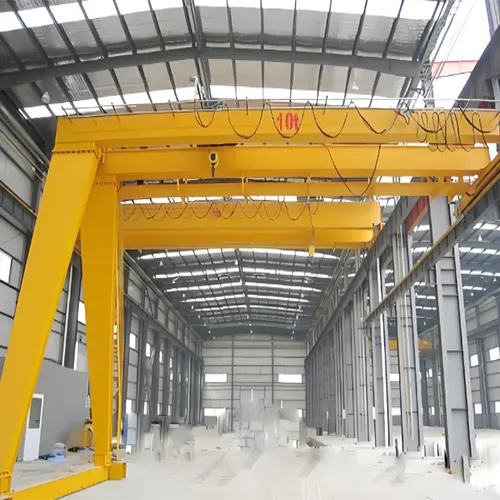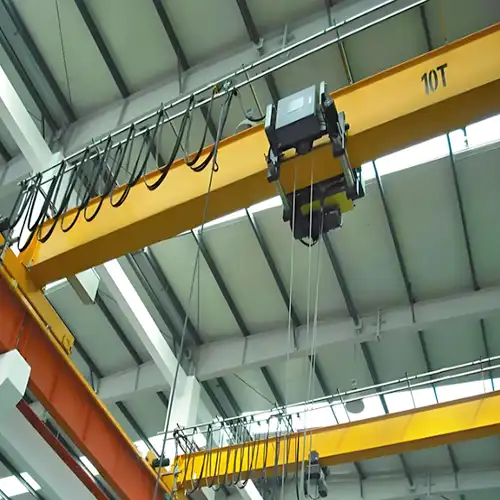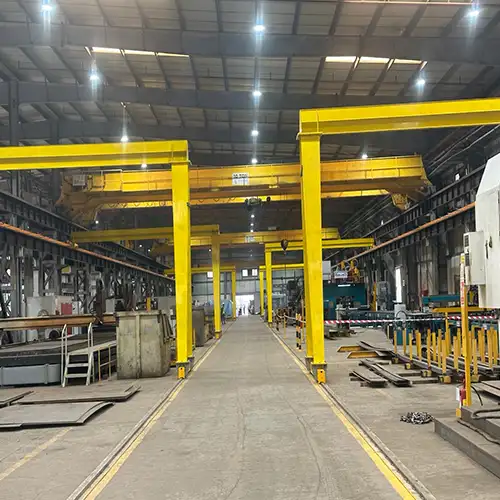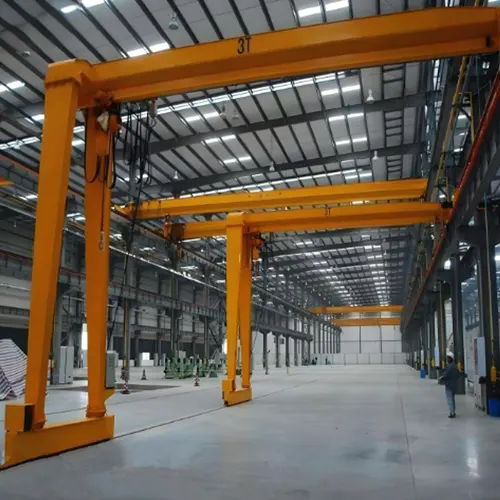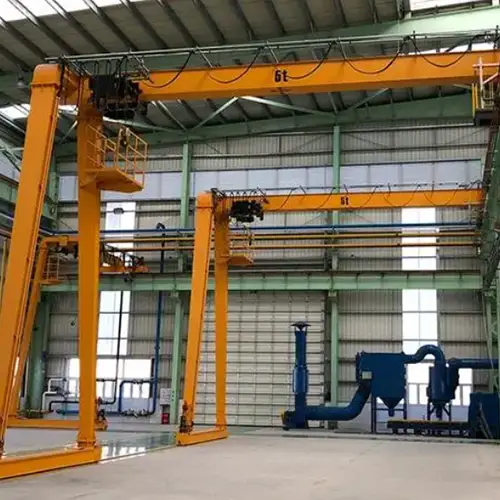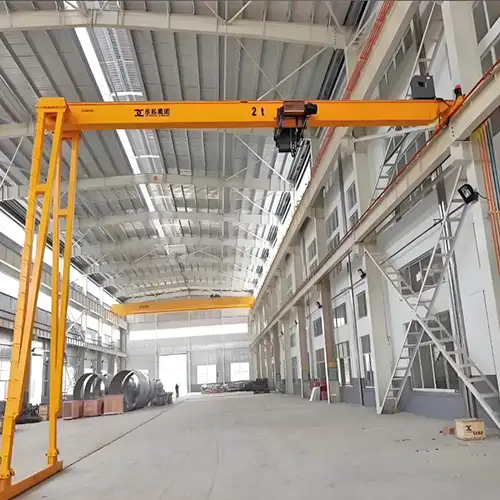Semi Portal Crane 10 Ton for Equipment Handling for Industrial Use
Semi portal crane10 ton for efficient equipment handling, custom semi-gantry crane for industrial applications. Get your semi gantry crane 10 ton design!
Category: Full& Half Gantry
Your Trusted Semi Gantry Crane and Semi Portal Crane Manufacturer & Supplier
Semi Portal Crane 10 Ton for Equipment Handling for Industrial Use
Semi portal crane10 ton for efficient equipment handling, custom semi-gantry crane for industrial applications. Get your semi gantry crane 10 ton design!
In the manufacturing sector, efficiently and safely handling heavy equipment is essential for maintaining productivity and ensuring operational safety. Challenges in equipment handling include managing the weight and size of machinery, maneuvering in tight spaces, and minimizing downtime during setup and relocation. These issues can affect production schedules, increase labor costs, and pose safety risks if not managed effectively.
A practical solution to these challenges is the use of semi portal cranes. These cranes offer a versatile and cost-effective option for lifting and moving equipment within manufacturing facilities. Unlike traditional fixed cranes, semi portal cranes combine substantial lifting capabilities with mobility, making them ideal for dynamic manufacturing environments.
The 10-ton semi portal crane is particularly notable for its ability to handle significant loads while adapting to various operational needs. With its 10-ton lifting capacity, this crane efficiently manages heavy machinery and equipment, offering flexibility and reliability. Its semi-portable design allows for easy relocation and setup in different areas of the facility, enhancing workflow and reducing equipment handling time. This blend of power and adaptability makes the 10-ton semi portal crane a valuable tool for modern manufacturing operations.
Basics of 10-Ton Semi Portal Cranes
Definition and Concept
A 10-ton semi portal crane is a type of industrial crane designed for lifting and moving heavy loads up to 10 tons (10,000 kilograms). It features a distinctive design that includes a semi-portal structure, meaning it combines elements of both a gantry crane and a portal crane, allowing it to be used in various industrial settings where high load capacities and flexibility are needed.
Key Characteristics
Structural Design:
- Semi-Portal Configuration: The crane typically consists of a horizontal beam supported by two vertical legs on one side and a cantilevered or shorter support on the other. This structure provides stability and allows for overhead lifting and movement.
- Gantry-Like Support: Unlike fully portal cranes, which have legs on both sides of the beam, semi portal cranes have one side that is fixed while the other side may have a cantilever or shorter support. This design allows for efficient space utilization.
Load Capacity:
- Lifting Capability: The crane is rated to handle loads up to 10 tons, making it suitable for heavy-duty lifting tasks in manufacturing and industrial environments.
Mobility and Versatility:
- Fixed Positioning: While the crane is semi-portable, it is generally designed to remain within a specific area or workspace. It offers the flexibility to handle loads within its operational range but is not intended for frequent relocation between different sites.
- Operational Range: The crane's design allows for movement along a track or rail system within its designated area, providing flexibility for maneuvering and handling different loads.
Construction Materials:
- Durability: Made from high-strength steel or alloy materials, the crane is built to withstand heavy loads and harsh operating conditions. Corrosion-resistant coatings are often applied to enhance durability and longevity.
Control Systems:
- Manual or Electric Controls: The crane can be operated using manual controls or electric systems, depending on the model. Advanced models may feature programmable controls and remote operation capabilities for added convenience and precision.
Benefits
The 10-ton semi portal crane offers substantial advantages due to its high load capacity. It is well-suited for handling large and heavy items, such as machinery, equipment, and industrial materials. This robust capacity ensures that the crane can manage demanding lifting tasks with ease.
Additionally, the crane's semi-portal design provides exceptional stability and balance during lifting operations. This reduces the risk of tipping or swaying, ensuring safer and more reliable performance, particularly when dealing with substantial loads.
The crane also provides notable flexibility in lifting and moving loads within a defined area. This adaptability makes it an ideal choice for manufacturing and assembly processes where space constraints are a significant consideration.
Applications
In the manufacturing sector, the 10-ton semi portal crane is used extensively in factories and workshops. It facilitates the lifting and movement of heavy machinery, components, and materials, contributing to efficient production processes.
In construction environments, the crane is equally valuable. It is well-suited for lifting and positioning heavy materials on construction sites, where its strength and stability play a crucial role.
For maintenance tasks, the crane proves highly effective in relocating or handling heavy equipment or parts. Its design allows for smooth and safe movement, making it an essential tool for maintenance operations.
Overall, the 10-ton semi portal crane merges high load capacity with a flexible and stable design, establishing itself as a valuable asset in a range of industrial and manufacturing settings.
Specifications of the 10-Ton Semi Portal Cranes
Load Capacity and Performance
- Lifting Capacity: Designed to handle up to 10 tons (10,000 kilograms). This capacity allows for the safe lifting and movement of heavy machinery, equipment, and materials.
- Lifting Height: Typically features a lifting height of up to 12 meters, though this can vary based on the crane's design and configuration. Custom options are available for specific height requirements.
- Span Length: The distance between the crane's legs or supports, which can range from 6 to 20 meters, depending on the application and facility layout.
- Hoisting Speed: Standard hoisting speeds range from 5 to 20 meters per minute, providing efficient lifting and lowering of loads. Variable speed options are available for more precise control.
- Travel Speed: The crane's trolley and hoist travel speeds usually range from 2 to 10 meters per minute, facilitating smooth and controlled movement.
Design and Build
- Construction Materials: Typically made from high-strength steel or alloy materials to ensure durability and structural integrity. Corrosion-resistant coatings may be applied for enhanced longevity in harsh environments.
- Structural Design: Features a robust design with a single or double girder configuration, depending on the model. The semi portal crane's structure includes support legs or columns that provide stability and load-bearing capacity.
- Dimensions: The overall dimensions of the crane vary based on its design and application. For instance, the height of the crane's legs might range from 3 to 6 meters, while the width and depth depend on the span and design requirements.
- Footprint: The crane's footprint is designed to ensure stability and balance. This includes the space occupied by the crane's support legs and the required clearance for safe operation and maintenance.
Mobility and Setup
- Mobility: Equipped with wheels or tracks for relocation within the installation area. Semi portal cranes offer mobility within a defined space but are not designed for frequent relocation between different sites.
- Setup: Generally requires a level and stable surface for installation. The crane's setup involves positioning, securing, and calibrating the crane, which can typically be completed in a few hours depending on the complexity.
Safety Features
- Emergency Stop: Includes emergency stop buttons and safety interlocks to prevent accidents and ensure safe operation.
- Overload Protection: Equipped with overload protection systems to prevent lifting beyond the crane's rated capacity.
- Anti-Collision Systems: Some models come with anti-collision sensors to prevent accidental impacts with structures or other equipment.
Power and Control
- Power Supply: Operates on standard industrial power supplies, typically 220V to 480V depending on the region and crane specifications.
- Control Systems: Includes manual or electric control options, with advanced models offering programmable controls and remote operation capabilities.
Maintenance Requirements
- Lubrication: Regular lubrication of moving parts is required to maintain smooth operation and prevent wear.
- Inspection: Periodic inspections are necessary to check for signs of wear, damage, or malfunction, ensuring safe and efficient operation.
These specifications ensure that the 10-ton semi portal crane meets the diverse needs of various industrial and manufacturing environments, providing reliable and efficient lifting solutions.
Standard Single Girder Semi Portal Crane
Design: The standard single girder semi portal crane features a single horizontal beam supported by two vertical legs, with the hoist mounted on a trolley that travels along the beam. This design allows for efficient overhead lifting and movement of loads. The crane's structure is straightforward, with one girder providing the necessary support for lifting operations.
- Comprises a single horizontal beam (girder) supported by two legs, one on the ground and the other connected to a wall or building structure.
- The hoist is mounted on a trolley that runs along the length of the beam, allowing for smooth and precise load movement.
- A hybrid design between a full gantry and overhead crane, combining floor-mounted stability with overhead lifting capabilities.
- Suitable for installations where space is limited or where overhead crane support structures are difficult to implement.

Characteristics: This crane design is known for its cost-effectiveness and simplicity. It is well-suited for moderate load handling within a specific area, making it ideal for facilities with confined spaces. The single girder design offers a balance between functionality and affordability, providing adequate lifting capability without the complexity of more advanced systems.
- Cost-Effective: The single girder design is less expensive than double girder or full gantry cranes due to reduced material and installation costs.
- Simple Operation: The straightforward design makes it easy to operate and maintain, with fewer components to monitor.
- Space-Efficient: Ideal for facilities with confined spaces or low headroom, as it utilizes both floor space and partial overhead space.
- Moderate Load Handling: Typically used for loads up to 10 tons, perfect for light to moderate-duty lifting tasks.
- Adaptability: Can be customized for specific applications, including different spans, heights, and hoisting speeds.
Applications: The standard single girder semi portal crane is versatile and commonly used in general industrial settings. It is suitable for handling light to moderate machinery and equipment, particularly in environments where space is limited. Typical applications include small to medium-sized manufacturing plants, workshops, and warehouses, where the crane's straightforward design and efficient operation meet the needs of routine lifting tasks.
- Manufacturing Plants: Used for handling machinery, components, and materials in small to medium-sized production facilities.
- Workshops: Suitable for lifting and moving equipment or parts in repair and maintenance workshops.
- Warehouses: Utilized for moving and positioning goods, especially where space is restricted and floor-level operations are crucial.
- Assembly Lines: Ideal for operations requiring precise load handling along production or assembly lines, enhancing workflow efficiency.
- Confined Spaces: Well-suited for environments where installing a full overhead crane system is impractical due to spatial limitations.
Benefits of a 10-Ton Semi Gantry Crane with Single Girder Design
A 10-ton semi gantry crane with a single girder design offers several advantages, particularly for industries seeking an efficient and cost-effective lifting solution.
- Cost-Effectiveness. The single girder design is more affordable than double girder systems, as it uses fewer materials and requires simpler installation. For applications that don't demand extremely heavy-duty lifting, a single girder crane provides an economical option without sacrificing performance.
- Space-Saving Design. Semi gantry cranes only require one leg on the floor, with the other side mounted to a wall or existing structure. This reduces floor space usage and makes them ideal for facilities with limited space. The compact single girder design further enhances their ability to operate in confined areas.
- Efficient Load Handling. With a 10-ton capacity, this crane is suitable for moderate to heavy-duty lifting tasks. The single girder allows for efficient handling of equipment and materials, offering reliable performance for various industrial processes.
- Ease of Installation and Maintenance. The straightforward design of a single girder semi gantry crane makes it easier to install and maintain. Fewer components reduce the complexity of the system, which translates to lower maintenance costs and minimal downtime during repairs or servicing.
- Flexibility in Use. Semi gantry cranes with single girders are highly adaptable and can be customized to fit specific needs. They are versatile enough to handle diverse lifting applications, from workshops and warehouses to small manufacturing facilities, making them a flexible choice for many industries.
- Improved Workflow Efficiency. The crane's design allows for smooth and precise movement along its path, ensuring the efficient transport of loads. This results in better workflow efficiency, especially in environments where equipment or materials need to be moved frequently.
In summary, a 10-ton semi gantry crane with a single girder design is a practical and economical solution for industrial settings that require moderate lifting capacity, efficient use of space, and reduced installation and maintenance costs.
Double Girder Semi Portal Crane
Design: The double girder semi portal crane is equipped with two parallel horizontal beams, which provide enhanced stability and increased lifting capacity. The hoist operates on trolleys that travel along both beams, allowing for greater control and precision. This design supports a more robust structural framework compared to single girder models.
- Features two parallel horizontal beams (girders) supported by a combination of one floor-mounted leg and one wall-mounted or structure-connected leg.
- The hoist is mounted on trolleys that run along both girders, providing greater stability, strength, and control during lifting operations.
- This design distributes the load more evenly across the crane, enhancing the crane's capacity to handle larger and heavier loads.
- Suitable for applications requiring more lifting height and extended spans, compared to single girder models.

Characteristics: This crane design offers several advantages over single girder systems, including greater lifting height and capacity. The double girder configuration improves load distribution, allowing the crane to handle heavier and larger loads more efficiently. The increased stability and strength make it suitable for demanding lifting tasks and environments where high performance is required.
- Increased Lifting Capacity: The double girder design allows for significantly higher load capacities compared to single girder cranes, typically handling heavier loads from 10 tons to upwards of 50 tons.
- Enhanced Stability: With two girders, the crane ensures better load distribution, providing more stability during lifting and travel operations.
- Higher Lifting Height: The dual-beam structure allows for increased lifting height, making it ideal for facilities that require vertical clearance for larger equipment.
- Precision and Control: The hoist travels on trolleys that run along both girders, offering greater control, precision, and smooth movement of heavy loads.
- Durability: Designed for heavy-duty applications, the double girder semi portal crane is built to withstand demanding environments, ensuring long-term performance and reliability.
Applications: The double girder semi portal crane is used in scenarios where heavy loads and larger equipment need to be managed. It is ideal for manufacturing facilities, assembly lines, and heavy-duty lifting tasks in larger industrial settings. The crane's robust design supports the handling of substantial equipment and materials, making it a valuable asset in environments where high lifting capacities and durability are essential.
- Heavy-Duty Manufacturing Facilities: Perfect for large-scale production plants where heavy machinery, parts, and materials need to be lifted and moved.
- Industrial Assembly Lines: Ideal for handling large and heavy components during the assembly process, ensuring smooth and efficient workflow.
- Warehouse Operations: Suitable for loading, unloading, and transporting large goods and equipment, especially in larger storage facilities.
- Shipyards and Docks: Commonly used in marine industries for handling heavy equipment, containers, and parts, especially in outdoor environments.
- Steel Mills and Foundries: Well-suited for handling large, heavy, and high-temperature loads such as steel and iron in extreme environments.
Key Benefits of Double Girder Semi Portal Cranes
One of the primary advantages of the double girder semi portal crane is its higher load capacity. Compared to single girder models, the double girder configuration allows the crane to manage much heavier loads, making it ideal for demanding industrial tasks. This increased capacity is essential for environments where heavy equipment, materials, or machinery must be handled safely and efficiently.
The double girder system also offers improved load control. Thanks to its robust structure and the use of trolleys on both girders, the crane provides smoother and more precise load handling. This added control enhances the safety and efficiency of operations, particularly when lifting and transporting large or awkward loads.
In terms of versatility, the double girder semi portal crane is well-suited for a wide range of heavy-duty applications across various industries. Whether used in manufacturing, construction, or shipyards, this crane design supports high-performance operations, ensuring maximum productivity and reliability in diverse industrial settings.
Specialized Semi Portal Cranes for Specific Applications
Explosion-Proof Semi Portal Crane
- Design: Constructed with explosion-resistant features to ensure safe operation in environments with flammable substances.
- Applications: Perfect for chemical plants, oil refineries, and facilities where explosive risks are present, providing secure handling of equipment and materials in hazardous atmospheres.
Anti-Corrosion Semi Portal Crane
- Design: Made with corrosion-resistant materials and coatings to endure harsh environments like coastal areas or chemical processing plants.
- Applications: Ideal for marine environments, coastal regions, and industries dealing with corrosive substances, maintaining durability and performance in conditions that would accelerate degradation.
High-Temperature Semi Portal Crane
- Design: Engineered to handle extreme temperatures with materials and features that resist thermal stress and ensure safe operation.
- Applications: Suitable for foundries or steel mills where exposure to high heat from molten metals or other hot processes is common.
Cleanroom Semi Portal Crane
- Design: Designed to adhere to cleanroom standards, featuring components that minimize particle generation and contamination.
- Applications: Essential for industries such as pharmaceuticals, electronics, and biotechnology, where maintaining a clean environment is critical for product integrity and safety.
Heavy-Duty Semi Portal Crane
- Design: Built with reinforced construction and robust components to manage exceptionally heavy loads.
- Applications: Used in heavy industries like shipbuilding, large-scale construction, or steel manufacturing, where handling very heavy machinery or components is required.
Modular Semi Portal Crane
- Design: Composed of modular components for easy assembly and disassembly, offering flexibility and adaptability.
- Applications: Ideal for construction sites or dynamic environments where frequent reconfiguration or relocation is needed, adapting to various tasks and layout changes.
Radio-Controlled Semi Portal Crane
- Design: Equipped with remote control systems for enhanced safety and operational convenience, allowing operators to control the crane from a distance.
- Applications: Suitable for situations where operator safety is a concern or in environments requiring precise control from a safe distance, such as hazardous or confined spaces.
These specialized semi portal cranes provide tailored solutions for diverse industrial needs, combining the adaptability of semi portal cranes with features designed for specific environmental and operational requirements.
Applications in Manufacturing Equipment Handling
Handling Heavy Machinery
Examples of Machinery That Can Be Managed with a 10-Ton Crane A 10-ton Semi Portal Cranes is well-suited for handling a variety of heavy machinery commonly found in manufacturing environments. Some examples include:
- Industrial Presses: Large presses used for stamping, forming, or machining metal and other materials.
- CNC Machines: Heavy computer numerical control (CNC) machines used for precision cutting and shaping.
- Heavy Motors and Generators: Large electric motors or generators used in industrial processes.
- Assembly Line Components: Significant components of automated assembly lines, including conveyors and robotic arms.
These examples illustrate the crane's capability to manage substantial equipment efficiently, which is crucial for maintaining smooth operations in a manufacturing setting.
Case Studies or Real-Life Applications In a large automotive manufacturing plant, a 10-ton Semi Portal Cranes was used to move and position heavy stamping presses on the production floor. The crane's mobility allowed it to be repositioned as needed, facilitating the installation and maintenance of the presses without requiring multiple fixed cranes. In another case, a metal fabrication facility used the crane to handle large sections of machinery during equipment upgrades. The crane's flexibility enabled quick relocation and setup, minimizing downtime and ensuring that operations continued smoothly.
Improving Workflow and Safety
How a Semi Portal Cranes Enhances Workflow Efficiency The Semi Portal Cranes enhances workflow efficiency by providing flexible equipment handling capabilities. Its ability to move within a designated area allows for quick repositioning and setup, reducing the time required to shift equipment between different production zones. This mobility ensures that heavy machinery can be accessed and managed with minimal disruption to ongoing operations. The crane's design supports efficient handling of large loads, streamlining processes such as equipment installation, maintenance, and relocation.
Safety Benefits and Risk Reduction The Semi Portal Cranes contributes to safety in several ways:
- Reduced Manual Handling: By automating the lifting and moving of heavy equipment, the crane minimizes the need for manual handling, which reduces the risk of injury to workers.
- Stable Operation: Its robust design and secure setup mechanisms ensure stable and reliable operation, lowering the risk of accidents caused by unstable equipment.
- Enhanced Precision: The crane's control systems allow for precise positioning of heavy loads, reducing the likelihood of equipment collisions or mishandling.
Overall, the 10-ton Semi Portal Cranes not only improves operational efficiency but also enhances safety by addressing key risks associated with heavy equipment handling.
Typical Loads or Objects Handled by 10-Ton Semi Portal Cranes
A 10-ton semi portal crane is designed to manage a wide variety of heavy loads and objects common in industrial and manufacturing settings. Below are some typical examples of what these cranes can efficiently handle:
Heavy Machinery and Equipment:
- Industrial Presses: These large machines used in metal forming and stamping can be maneuvered and positioned with precision using a 10-ton crane.
- CNC Machines: Computer Numerical Control (CNC) machines, essential for precision cutting and machining, often require significant lifting capacity for safe relocation and setup.
- Milling Machines: Large milling machines used for machining solid materials are easily handled by this crane.
Large Components and Assemblies:
- Engine Blocks: Heavy engine blocks for automotive, industrial, or marine applications can be lifted and transported with ease.
- Generator Sets: Large generator sets used for power generation are effectively managed by a 10-ton crane.
- Turbine Components: Various turbine parts, used in energy production and manufacturing, are well within the crane's lifting capability.
Structural Elements:
- Steel Beams: Heavy steel beams for construction and infrastructure projects can be accurately lifted and positioned.
- Support Columns: Large support columns for buildings or machinery can be handled and placed as needed.
Manufacturing Materials:
- Bulk Material Containers: Containers with bulk materials, such as metal ingots or large bags of raw materials, can be managed effectively.
- Production Molds: Large molds used in casting processes can be efficiently lifted and moved.
Maintenance and Repair Tasks:
- Replacement Parts: Heavy replacement parts for machinery or infrastructure can be positioned for maintenance or replacement.
- Equipment Overhauls: During equipment overhauls, large components needing removal or installation are managed effectively.
The 10-ton semi portal crane is a versatile asset that provides the necessary lifting capacity for a range of heavy-duty tasks, making it invaluable in various industrial and manufacturing environments.
Comparative Analysis
Semi Portal Cranes vs. Fully Portal Cranes
When choosing the right crane for your facility, understanding the differences between semi portal cranes and fully portal cranes is essential. Both types offer unique advantages depending on your operational needs, workspace constraints, and load requirements. Semi portal cranes, with their hybrid design combining fixed and movable components, provide flexibility and adaptability in constrained spaces. In contrast, fully portal cranes feature a robust, freestanding structure designed for greater stability and load capacity, making them suitable for larger, more open environments. This comparison explores the key distinctions and applications of each type to help you make an informed decision based on your specific requirements.
Design and Structure:
- Semi Portal Cranes: These cranes feature one vertical leg and one horizontal beam supported by a pair of wheels or tracks, with the other end of the beam supported by a wall or a structure. This design provides flexibility in applications within confined spaces and is often used in facilities where space limitations prevent the use of fully free-standing cranes.
- Full Portal Cranes: Full portal cranes have two vertical legs and two horizontal beams forming a complete frame. This structure supports the crane independently of external supports, allowing it to span a wider area. The full portal design is more stable and offers greater lifting capacity and height compared to semi portal cranes.
Mobility and Flexibility:
- Semi Portal Cranes: These cranes are often mounted on a single side, which allows them to be positioned close to walls or other structures, making them ideal for operations in limited spaces. They are less mobile compared to full portal cranes but can be more versatile in environments where floor space is restricted.
- Full Portal Cranes: Full portal cranes are typically more mobile and can be used in larger open spaces. Their complete frame allows for greater freedom of movement across the entire span of the crane, making them suitable for larger facilities where full independence from structural supports is beneficial.
Capacity and Performance:
- Semi Portal Cranes: While these cranes can handle substantial loads, their capacity is generally lower than that of full portal cranes due to the support constraints. They are effective for moderate to heavy loads but are typically used where the crane's footprint is limited by existing structures.
- Full Portal Cranes: Designed for higher lifting capacities and larger spans, full portal cranes can handle heavier loads and larger equipment. Their robust design supports greater stability and load distribution, making them suitable for heavy-duty lifting tasks in expansive industrial environments.
Installation and Space Requirements:
- Semi Portal Cranes: Installation of semi portal cranes is generally simpler in confined spaces since they can be anchored to existing structures. However, their use is constrained by the need for wall or structure support on one end.
- Full Portal Cranes: These cranes require more space for installation due to their full frame and need for a clear span. They are best suited for facilities with ample space and where a fully independent lifting solution is needed.
Cost Considerations:
- Semi Portal Cranes: Generally more cost-effective due to simpler construction and installation requirements. They offer a good balance between cost and functionality for specific applications within limited spaces.
- Full Portal Cranes: Typically more expensive due to their robust construction and the greater amount of materials required. They provide enhanced performance and capacity, justifying the higher investment in facilities with more space and demanding lifting requirements.
In summary, the choice between semi portal cranes and full portal cranes depends on specific operational needs, including space constraints, load requirements, and budget. Each type offers unique advantages that make them suitable for different industrial applications.
10-Ton Semi Portal Cranes vs. Overhead Bridge Cranes: Single Girder and Double Girder Designs
When selecting a crane system for your facility, understanding the differences between various designs is crucial. Both semi portal cranes and overhead bridge cranes offer unique advantages, particularly in their single girder and double girder configurations. This comparison aims to highlight the key distinctions and help you choose the most suitable crane design based on your operational needs and facility constraints.
Design and Structure:
Semi Portal Cranes:
- Single Girder Design: Features one horizontal beam supported by vertical legs on one side. This design is ideal for smaller, more confined spaces where high flexibility is needed. The single girder allows the crane to move within a limited area, making it a practical choice for lighter loads and restricted environments.
- Double Girder Design: Equipped with two parallel horizontal beams, offering enhanced stability and lifting capacity. This setup not only supports greater lifting heights but also improves load distribution. It is a robust option for applications requiring higher strength and stability, suitable for larger industrial environments.
Overhead Bridge Cranes:
- Single Girder Design: Consists of a single horizontal beam mounted on end trucks that travel along rail tracks. This design is typically used in smaller or medium-sized facilities where space is at a premium. It efficiently handles lighter loads and covers the span of the facility with minimal infrastructure.
- Double Girder Design: Features two parallel beams supported by end trucks, providing superior lifting capacity and height. This design is ideal for large-scale facilities or heavy-duty applications, offering exceptional strength and stability for demanding lifting tasks.
Applications and Usage:
Semi Portal Cranes:
- Single Girder: Perfect for smaller manufacturing or assembly environments where space constraints and moderate load requirements are factors. It is used for tasks such as handling small machinery or components within a confined area, offering efficient operation in limited spaces.
- Double Girder: Suited for larger industrial plants or workshops where high lifting capacities and stability are needed. It effectively handles heavier machinery and equipment, providing the strength and precision required for more demanding tasks.
Overhead Bridge Cranes:
- Single Girder: Commonly employed in warehouses or smaller manufacturing setups, this design is ideal for moderate lifting needs and covers the facility's span efficiently. It balances space and functionality, making it suitable for less intensive applications.
- Double Girder: Best for extensive manufacturing plants, steel mills, or heavy-duty applications requiring high lifting heights and substantial capacities. It provides the strength and stability necessary for complex and heavy lifting operations.
Key Differences:
- Capacity and Stability: Double girder designs, whether in semi portal or overhead bridge cranes, generally offer higher lifting capacities and greater stability compared to single girder designs, making them suitable for more demanding applications.
- Space Requirements: Single girder designs are more compact and fit better in spaces with limited room, while double girder designs, though requiring more space, provide greater functionality and strength.
- Flexibility: Semi portal cranes offer greater flexibility in positioning within confined areas, while overhead bridge cranes provide extensive coverage across larger facilities but are less adaptable to restricted spaces.
Conclusion: Choosing between semi portal cranes and overhead bridge cranes, as well as selecting between single and double girder designs, depends on specific factors such as load requirements, available space, and operational needs. Understanding these differences will help you make an informed decision that optimizes your facility's efficiency and productivity.
Choosing the Right Crane Based on Needs
When deciding between a Semi Portal Cranes and a fully portable crane, it's important to consider several key factors to ensure you select the most suitable option for your operations.
Operational Requirements
The nature of your tasks plays a crucial role in choosing the right crane. If your operations involve handling heavy machinery or substantial loads, and require occasional repositioning within a specific area, a Semi Portal Cranes is often the better choice. Its robust construction and higher lifting capacity make it well-suited for these tasks. On the other hand, if your work involves lighter tasks that require frequent relocation between different job sites, a fully portable crane may be more appropriate. Fully portable cranes are designed for maximum mobility, making them ideal for scenarios where equipment needs to be moved often.
Workspace and Layout
Consider the constraints of your workspace and layout. In facilities with limited space or complex arrangements, a Semi Portal Cranes can move within a confined area without needing to be disassembled or reassembled frequently. This flexibility can be advantageous in tight environments. Conversely, if your operations require equipment to be transported between widely separated locations, a fully portable crane offers greater flexibility and ease of movement across different sites.
Cost Considerations
Budget is another important factor. Generally, fully portable cranes are less expensive than Semi Portal Cranes s due to their simpler design and lighter construction. However, if your tasks require a crane with higher lifting capacities and a more robust construction, investing in a Semi Portal Cranes might provide better long-term value despite the higher initial cost. Weigh the upfront investment against the benefits of higher capacity and durability to determine the most cost-effective solution for your needs.
Frequency of Relocation
Assess how often the crane needs to be relocated. If frequent movement across different job sites is necessary, a fully portable crane offers the needed mobility and ease of relocation. For operations that involve occasional repositioning within a set area, a Semi Portal Cranes provides a balanced solution with sufficient capacity and manageable movement.
By carefully evaluating these factors—operational requirements, workspace constraints, budget, and relocation frequency—you can determine which type of crane best meets your specific needs. This ensures you choose the right crane to optimize your manufacturing processes, balancing mobility and lifting capacity effectively.
Conclusion
The 10-ton Semi Portal Cranes offers numerous advantages for handling heavy equipment in manufacturing environments. Its substantial lifting capacity of 10 tons makes it ideal for managing large and cumbersome machinery, from industrial presses to CNC machines. The crane's semi-portable design strikes an effective balance between mobility and stability, allowing for flexibility in equipment placement while maintaining the robustness needed for heavy-duty tasks.
Key benefits include:
- Enhanced Flexibility: The crane's ability to move within a designated area supports efficient handling and repositioning of equipment, which is crucial for dynamic manufacturing environments.
- Cost-Effectiveness: Compared to fully portable and stationary cranes, the Semi Portal Cranes provides a cost-effective solution that offers both high capacity and mobility without the need for extensive infrastructure investment.
- Improved Safety: By reducing the need for manual handling and providing stable, controlled lifting, the crane enhances workplace safety and minimizes the risk of accidents.
Using a 10-ton Semi Portal Cranes in your manufacturing facility can significantly enhance both operational efficiency and safety. The crane's robust lifting capability and adaptable design streamline equipment handling, reduce downtime, and improve overall workflow. Its ability to move within a specific area while handling heavy loads ensures that manufacturing processes remain smooth and productive.
Additionally, by automating the lifting and moving of heavy equipment, the crane reduces the physical strain on workers and lowers the risk of injury. Its stable operation and precise control contribute to a safer working environment, protecting both personnel and valuable machinery.
In summary, the 10-ton Semi Portal Cranes stands out as a valuable asset for manufacturing operations, offering a blend of strength, flexibility, and safety that drives productivity and operational excellence. Investing in such equipment not only addresses the challenges of handling heavy machinery but also supports a safer and more efficient manufacturing process.
Main Projects
Related Products

Supplied three grab bucket crane kits to Indonesia, enhancing garbage handling efficiency with high load capacity and reliable performance.
Free consultation to Confirm Parameters & Specifications and Get
Latest Crane Price & Crane Rate.
- Types of overhead cranes : _______?
- Optional: Overhead travelling crane, goliath gantry crane,Slewing jib crane, Single girder or double girder crane,small portable crane or kbk crane, etc.
- Capacity of overhead crane: _______?
- Optional: 0.25ton, 0.5 ton, 1 ton, 2 ton, 3ton, 5 ton, 10 ton,15ton, 20ton, 25 ton, 30ton,35ton, up to 550ton, etc.
- Crane span & lifting height : _______?
- Crane travelling length : _____?
- Control of overhead crane:_______?
- Optional: pendant/ remote/cabin control
- Voltage supply of overhead crane:_____?
- Eg,: 380V50/60HZ,3Phase or others,etc.
- Application/usage of crane:_______?
- Eg,: Steel mill, ,injection mold, cement,stone, concrete,granite, general manufacturing, etc.
Just leave a message via the contact form and our hoist and crane engineer will contact you with in 24working hours.
Get In Touch
